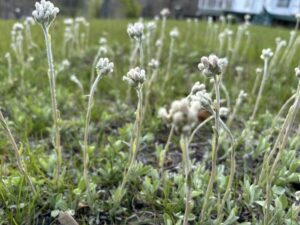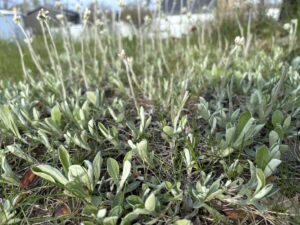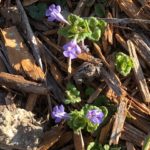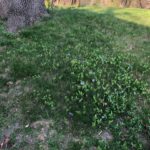by Winding Pathways | May 2, 2024 | (Sub)Urban Homesteading, Garden/Yard, Nature
Field Pussytoes delight us! (And, we plan to encourage them)
Early this spring a lawn care company dropped by and offered to spray our lawn. “We’ll keep the weeds out,” said the enthusiastic young man.
He knocked at the wrong door. We take joy in our lawn’s diversity, and soon after he visited delightful patches of Field Pussytoes sent up stems with their flowers in our lawn. Serendipity.
Field Pussytoes has the intriguing scientific name of Antennaria neglecta. Ours is one of several species of pussytoes that grace unsprayed yards. The word antennaria comes from the plant’s spikey flowers that look like an insect’s antennae. And neglecta? Well, because we are “neglecting” our lawn by not poisoning it, this humble plant thanks us. It needs little care and grows across much of North America.
This native plant thrives in conditions that describe most lawns. It enjoys full sun to partial shade, spreads by rhizomes, and is one of the earliest lawn “weeds” to flower. Its delicate blooms look like a kitten’s feet and toes. Field Pussytoes is pollinated by insects but bypassed by deer and rabbits.
Many years ago, Marion interviewed Lady Bird Johnson at the Lady Bird Johnson Wildflower Center near Austin, Texas. No doubt the former first lady enjoyed blooming pussytoes. The organization she formed has an outstanding website that helps anyone identify and enjoy plants.
Winding Pathways Lawn Management
We don’t neglect our lawn. We encourage native plants that need little care and which enrich the soil. As needed, we run a mower over it, but we’re always on the lookout for unusual plants that volunteer amid the grass. Some are delightful, and a few could be pests, but all are fascinating.
Our lawnmower helps us select the most interesting plants. Many that we might not want, like invasive sweet clover and garlic mustard, tend to grow tall. Our mower never gives them a chance. Field Pussytoes, like violets, hug the ground and escape the mower’s whirling blade. When done blooming, the plants form loose, sage-green mats that need no mowing at all! Gradually they’ve expanded.
One of the fundamentals of classic ecology is that diversity implies stability. Spraying a lawn destroys diversity, creating an unstable monoculture. We escape cost and possible chemical danger by not spraying our lawn. Pussytoes are just one of many fascinating plants that moved in and have spread on their own.
-

-
Blooms stand up several inches.
-

-
Field Pussytoes hug the ground
by Winding Pathways | May 24, 2018 | (Sub)Urban Homesteading, Flowers/Grasses, Foraging, Garden/Yard, Garden/Yard, Weeds
Years ago, a homeowner visited a garden store and bought plugs of a plant commercially called ground ivy, but most folks today call it Creeping Charlie.

A great ground cover that can get away from you.
In many ways this exotic plant was an ideal ground cover. It’s tough, easy to transport and plant, adaptable to a wide range of conditions, needs no special care, and it spreads like crazy. It only grows a few inches tall so was touted as a plant that, once established, needs no maintenance. And, it attracts valuable pollinators early in the season before other flowering blooms appear.
Benefits
Creeping Charlie’s benefits are also its curse. It does everything too well. Creeping Charlie doesn’t creep. Rather, it races to cover a yard with astonishing speed, often crowding out more desirable plants.
There are two ways to view Creeping Charlie.
It’s either a pernicious pest or a friend that needs little care. At Winding Pathways, we look at it both ways depending on where it’s growing. When it’s crowding wildflowers or our garden vegetables we rip it out of the ground. In places where it can’t infect a garden or native wildflowers we leave it be and know we won’t need to mow that area often.
Controlling Creeping Charlie
There are lots of ways to control Creeping Charlie. We pull it out of the ground. Roundup and other herbicides kill it, and it’s possible to smother it under black plastic sheeting. Mulch works for a while but soon the plant will thrive on even a thick layer of shredded wood mulch.
A member of the mint family and also known more romantically by an elderly Irish friend as “Gill-Over-the-Ground”, Creeping Charlie is also edible steamed, added to omelets or brewed as a tea.
Other Ground Covers
We prefer ground covers that are less aggressive than Creeping Charlie. One of our favorites is the native Pussy Toes, which grows in patches in our lawn. We planted some when we moved in eight years ago and because we don’t put herbicides on our lawn it is spreading nicely. It is hardy and thrives in dry, sandy soil in baking sun. The hairy, silvery leaves lie close the ground and in spring send up enchanting stems with little “pussy toe” flowers. The Lady Bird Wildflower Center confirms this native plant is widely spread and thrives in open meadows and woodlands and rocky areas. We’ve seen it all over the eastern half of the country and Canada. We love it! Again, it saves mowing, adds color and texture to the landscape and attracts early season pollinators.
We also use Vinca, with its periwinkle flowers, on some parts of our lawn especially areas we do not want to mow. It spreads easily, adds color and texture to the landscape and reduces maintenance.
-

-
Pollinators like ants flock to pussytoes.
-

-
An excellent ground cover.
-

-
Pretty purple violets.
Our lawn actually is a mosaic of many plants. Since we shun herbicides we have a lawn blend of grasses, violets, dandelions, pussytoes, and many other plants. They are all fascinating and help pollinators through the seasons.






